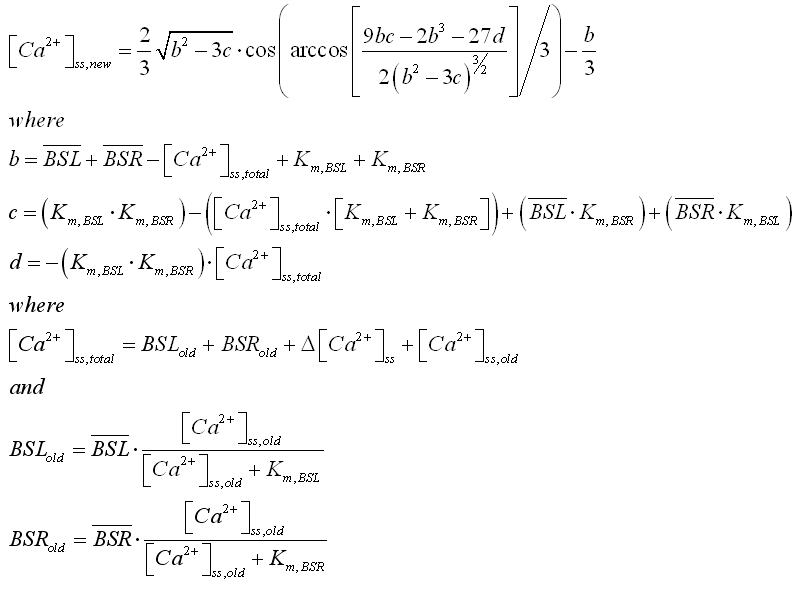We carefully checked that the model reaches stable quiescence as well as a steady state response to periodic pacing. However, for continuous pacing of extremely long duration, beyond 2 hours of simulation time, small numerical errors could appear as a result of machine precision. These numerical errors are completely eliminated by using an analytical expression for the calculation of subspace Ca2+ (Zeng J, Laurita KR, Rosenbaum DS, Rudy Y. Circ Res. 1995;77:140-152), which amounts to replacing the differential equations for buffering and subspace Ca2+ with the equations below. The Hund-Rudy model code available on this website already computes analytically subspace Ca2+, and has been tested to reach a stable steady-state for all (short and long) pacing conditions.
 Definitions are as follows (concentrations given in mmol/L): [Ca2+]ss indicates free [Ca2+]ss in the subspace; BSL, concentration of Ca2+ buffered by anionic sarcolemmal binding sites for Ca2+ in the subspace;
Definitions are as follows (concentrations given in mmol/L): [Ca2+]ss indicates free [Ca2+]ss in the subspace; BSL, concentration of Ca2+ buffered by anionic sarcolemmal binding sites for Ca2+ in the subspace; ![]() , maximum concentration of Ca2+ buffered by anionic sarcolemmal binding sites for Ca2+ in the subspace; BSR, concentration of Ca2+ buffered by anionic binding sites for Ca2+ in the subspace;
, maximum concentration of Ca2+ buffered by anionic sarcolemmal binding sites for Ca2+ in the subspace; BSR, concentration of Ca2+ buffered by anionic binding sites for Ca2+ in the subspace; ![]() , maximum concentration of Ca2+ buffered by anionic binding sites for Ca2+ in the subspace; Km,BSL and Km,BSR , equilibrium constants of buffering by BSL and BSR respectively; and
, maximum concentration of Ca2+ buffered by anionic binding sites for Ca2+ in the subspace; Km,BSL and Km,BSR , equilibrium constants of buffering by BSL and BSR respectively; and ![]() [Ca2+]ss, change in total Ca2+ amount during one time step. The subscripts ss , new , and old indicate subspace, present time step, and previous time step, respectively.
[Ca2+]ss, change in total Ca2+ amount during one time step. The subscripts ss , new , and old indicate subspace, present time step, and previous time step, respectively.